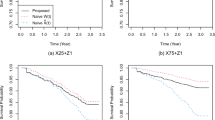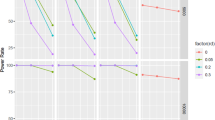Abstract
Subject withdrawal from a study (also called dropout, or right censoring), is common in late phase clinical trials. A number of methods dealing with dropouts have been used in practice, the most common being “last observation carried forward” (LOCF). Many of these methods, including LOCF, can result in biased estimates of the efficacy or potency of the drug, especially in the modeling context. If the likelihood of dropout is correlated to the underlying unobserved data, the dropout is informative and should not be ignored in the modeling process. The topic of informative dropout in the context of longitudinal data has received much attention in the statistical literature, in the setting of linear and generalized linear models. We extend the approach to nonlinear models. The dropout hazard, as well as the longitudinal data, is modeled parametrically. Parameters are estimated by maximizing the approximate joint likelihood as implemented in the software NONMEM. Using data from actual clinical trials, we explore the impact of the dropout model on the ability of the joint model to predict observed longitudinal data patterns.
Similar content being viewed by others
REFERENCES
K. Unnebrink and J. Windeler. Intention-to-treat: methods for dealing with missing values in clinical trials of progressively deteriorating diseases. Stats. in Med. 20:3931-3946 (2001).
J. Xu and S. L. Zeger. Joint analysis of longitudinal data comprising repeated measures and times to events. Appl. Stats. 50:375-387 (2001).
L. B. Sheiner, S. L. Beal, and A. Dunne. Analysis of nonrandomly censored ordered categorical longitudinal data from analgesic trials. J. Amer. Stats. Assn. 92:1235-1255 (1997).
J. W. Mandema and D. R. Stanski. Population pharmacodynamic model for ketorolac analgesia. Clin. Pharmacol. Therapeut. 60:619-635 (1996).
M. C. Wu and R. J. Carroll. Estimation and comparison of changes in the presence of informative right censoring by modeling the censoring process. Biometrics 44:175-188 (1988).
J. W. Hogan and N. M. Laird. Model-based approaches to analysing incomplete longitudinal and failure time data. Stats. in Med. 16:259-272 (1997).
D. B. Rubin. Inference and Missing Data. Biometrika 63:581-592 (1976).
P. Diggle and M. G. Kenward. Informative drop-out in longitudinal data analysis. Appl. Stats. 43:49-93 (1994).
J. Carpenter, S. Pocock, and C. J. Lamm. Coping with missing data in clinical trials: a model-based approach applied to asthma trials. Stats. in Med. 21:1043-1066 (2002).
A. Sharma and W. J. Jusko. Characteristics of indirect pharmacodynamic models and applications to clinical drug responses. Br. J. Clin. Pharmacol., 45:229-239 (1998).
Beal, S. L. and Sheiner, L. B. NONMEM user's guide, 1992. NONMEM project group, UCSF.
Y. Yano, S. L. Beal, and L. B. Sheiner. Evaluating pharmacokinetic/pharmacodynamic models using the posterior predictive check. J. Pharmacokin. Pharmacodynam. 28:171-192 (2001).
J. P. Klein and M. L. Moeschberger. Survival Analysis, Springer, New York, 1997.
M. S. Wulfsohn and A. A. Tsiatis. A joint model for survival and longitudinal data measured with error. Biometrics 53:330-339 (1997).
Jonsson, E. N. and Sheiner, L. B. More efficient clinical trials through use of scientific-model-based statistical tests. Clin. Pharmacol. Therapeut. 72:603-614 (2002).
R. J. A. Little and D. B. Rubin. Statistical Analysis With Missing Data, John Wiley and Sons, 2002.
Author information
Authors and Affiliations
Corresponding author
Rights and permissions
About this article
Cite this article
Hu, C., Sale, M.E. A Joint Model for Nonlinear Longitudinal Data with Informative Dropout. J Pharmacokinet Pharmacodyn 30, 83–103 (2003). https://doi.org/10.1023/A:1023249510224
Issue Date:
DOI: https://doi.org/10.1023/A:1023249510224




